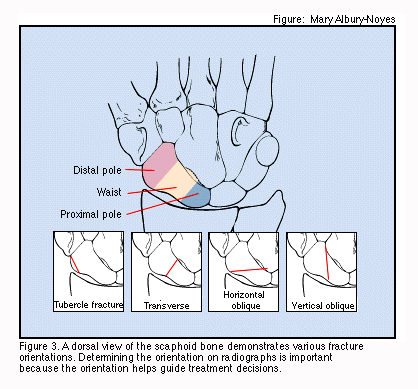Scaphoid Fracture: Difference between revisions
No edit summary |
No edit summary |
||
| Line 18: | Line 18: | ||
Most injuries are seen in men aged 15-30. 75-80% of fractures occur through the waist of the bone. 15-20% occur at the proximal pole. 10-15% of fractures occur at the distal pole.<ref name="bethel" /><br> | Most injuries are seen in men aged 15-30. 75-80% of fractures occur through the waist of the bone. 15-20% occur at the proximal pole. 10-15% of fractures occur at the distal pole.<ref name="bethel" /><br> | ||
[[Image:Scaphoid_fracture_types.gif|center|Scaphoid regions and types of fractures]] | |||
== Clinical Presentation == | == Clinical Presentation == | ||
Revision as of 19:16, 14 July 2013
Original Editor - Dawn Waugh
Top Contributors - Dawn Waugh, Mats Vandervelde, Abbey Wright, Inoa De Pauw, Admin, Chrysolite Jyothi Kommu, Kim Jackson, Evan Thomas, Rachael Lowe, Amanda Ager, Anas Mohamed, Wanda van Niekerk, Lucinda hampton, Johnathan Fahrner, WikiSysop, Claire Knott, 127.0.0.1, Nupur Smit Shah, Vanessa Rhule and Naike De Win
Clinically Relevant Anatomy
[edit | edit source]
The scaphoid is the most commonly fractured of the 8 carpal bones of the wrist. It is made up of a proximal and distal pole which are joined by a waist. Scapohid fractures make up 50-80% of all carpal fractures. [1] Blood supply is provided by a subdivision of the radial artery and travels distal to proximal. The proximal pole has no direct blood supply and is prone to avascular necrosis (AVN).[2]
Mechanism of Injury / Pathological Process
[edit | edit source]
Mechanism of injury is usually a fall onto an outstretched arm with wrist hyperextended and radial deviation. This position causes axial loading through the scaphoid. Less common mechanisms of injury are:
- wrist extension with deceleration such as with the hand on a steering wheel
- 'kickback' injuries from machinery
- hyperflexion injuries
- direct impact to the scaphoid
Most injuries are seen in men aged 15-30. 75-80% of fractures occur through the waist of the bone. 15-20% occur at the proximal pole. 10-15% of fractures occur at the distal pole.[2]
Clinical Presentation[edit | edit source]
Clinical presentation includes swelling and pain over the anatomical snuff box. The anatomical snuff box is the area between the extensor pollicis longus and the extensor pollicis brevis. Patient will usually also complain of pain with pressure over the scapoid tubercle. [2]
Diagnostic Procedure
[edit | edit source]
AP and lateral radiographs along with additional scaphoid views (pronated oblique and ulnar-deviated oblique) are used in diagnosing a scaphoid fracture. Up to 15% of scaphoid fractures are not evident on initial radiograph, however. [2] If fracture is suspected,MRI is the next line of imaging to confirm the diagnosis. [3]
Outcome Measures[edit | edit source]
DASH (see Outcome Measures Database)
Management / Interventions
[edit | edit source]
Cast immobilization is the standard treatment for treating a scaphoid fracture. With cast immobilization, chance of non-union is approximately 20%. Therefore, with displaced or unstable fractures, operative treatment is recommended. [4] Though this improves the rate of non-union, the complication rate for ORIF is 30%.[5]
Fractures are usually classified by Herbert and Fisher's system:
A: Acute but stable fractures such as fractures of the tubercle, incomplete or undisplaced fractures of the waist
B: Acute unstable fractures such as distal oblique fractures, complete waist fractures, proximal pole fractures, and
fracture dislocation
C: Fractures with evidence of delayed union
D: Fractures with established non-union[2]
Differential Diagnosis
[edit | edit source]
Differential diagnosis includes Colles' fracture, Salter-Harris fracture, other carpal fractures, scapho-lunate complex injury.[2]
Key Evidence[edit | edit source]
A systemic review suggests that percutaneous fixation may result in faster union and return to work or sport. There was no difference noted between cast fixation and ORIF. The authors suggest that cast treatment is a good treatment option for most. Surgery should be reserved for high level athletes and manual workers who cannot work in a cast.[5]
Resources
[edit | edit source]
Case Studies[edit | edit source]
add links to case studies here (case studies should be added on new pages using the case study template)
Recent Related Research (from Pubmed)[edit | edit source]
Failed to load RSS feed from http://eutils.ncbi.nlm.nih.gov/entrez/eutils/erss.cgi?rss_guid=1H9AR3ZQQCaD17U2nZhRHO0f8iHnyie26kobpe8zfqRJgmvYyC|charset=UTF-8|short|max=10: Error parsing XML for RSS
References[edit | edit source]
References will automatically be added here, see adding references tutorial.
- ↑ Alshryda SJM, Shah AB, Rhodes S, Odak SS, Murali SR, Ilango B. Interventions for treating acute fractures of the carpal scaphoid bone in adults. Cochrane Database of Systematic Reviews 2007, Issue 2. Art. No.: CD006523. DOI:fckLR10.1002/14651858.CD006523.fckLRA B
- ↑ 2.0 2.1 2.2 2.3 2.4 2.5 Bethel J. Scaphoid Fracture: diagnosis and management. Emergency Nurse. July, 2009. 17(4): 24-29.
- ↑ Henriksen et al. Two-Dimensional Image Fusion of Planar Bone Scintigraphy and Radiographs in Patients with Clinical Scaphoid Fracture: An Imaging Study. Acta Radiologica. February, 2009. 50(1): 71-77.
- ↑ Pfeiffer et al. A prospective multi-center cohort study of acute non-displaced fractures of the scaphoid: operative versus non-operative treatment. BMC Musculoskeletal Disorders. May, 2006. 7:41.
- ↑ 5.0 5.1 Modi et al. Operative versus nonoperative treatment of acute undisplaced and minimally displaced scaphoid waist fractures-A systemic review. Injury, Int. J. Care Injured. 2009. 40: 268-273.







